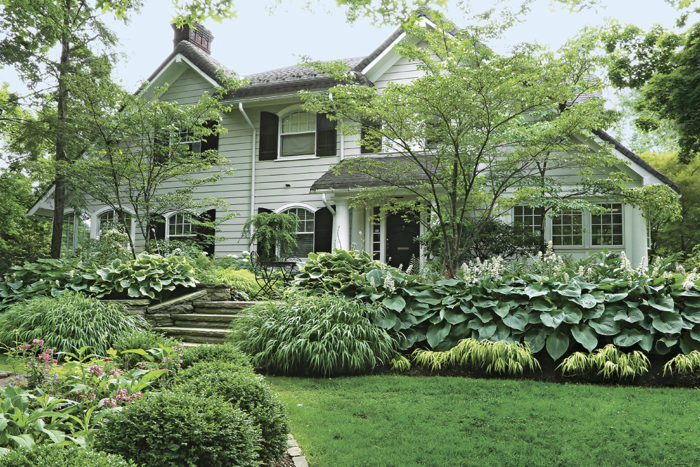
When Catherine Feldman first moved to her home in Shaker Heights, Ohio, the garden was essentially a blank slate. She dreamed of bringing the neglected landscape back to life and creating a storybook setting for her English cottage–style home. Arched windows and rolled eaves give the house distinctive charm, and Catherine’s garden design evolved to include a series of curved lines that highlight and complement these architectural details. The resulting landscape is inviting, intriguing, and full of life.
A custom-designed oval swimming pool served as the starting point for the curvilinear theme. Catherine got the idea on a tour of the iconic Dumbarton Oaks garden in Washington, D.C., where she fell in love with a dark, oval reflecting pool.
This water feature introduced a graceful curved line to the garden. Realizing that a shape like this would work well with her home’s architecture, Catherine had a design idea to build on.
Over the years, she has incorporated a series of carefully placed curves and ellipses throughout her garden. The swimming pool is the most striking feature of the space, its effect enhanced and subtly repeated by curved lines rendered in a variety of materials.
Open curves add energy, and closed curves invite the eye to pause

As you move through the Feldman garden, arcs and open curves lend a sense of movement and energy to the design. The eye can’t help but follow each curved line’s trajectory through the landscape.
Sweeping pathways direct garden traffic in a similar way, drawing the visitor through the space. Because your destination is screened from view, revealed only as you round the bend, curved pathways add an element of satisfying suspense.
Curves in the landscape appear to change as you move toward them and around them. Ovals widen to become perfect circles as you approach. Curving lines seem to deepen or stretch out when viewed from different perspectives. These elements give the landscape a sense of vitality that would be difficult to achieve in any other way.

While arcs and open curves lend energy and motion to Catherine’s garden, circles and ellipses evoke a feeling of peaceful completion. The effect is heightened and enhanced with the addition of water.

The swimming pool’s dark ellipse is the heart of the private back garden, highlighted with pale limestone pavers. Its lines are picked up by fences, raised beds, furnishings, and planters throughout the space. A small circular pond, tucked away in a quiet corner, subtly repeats the visual pattern of the swimming pool on a smaller scale.
In a more public area, the arrow-straight front walk is softened by a series of perfect circles. Half-circle beds flank the pathway, and circular capstones top the retaining walls on each side of the stair leading up to the front door. A round brick patio in front of the portico provides a place to pause before entering or leaving the house.
Straight lines maintain visual balance
The curved elements of Catherine’s garden are complemented by solid straight lines, energetic diagonals, and carefully sited vertical columns. These secondary design motifs, which tie back to the architecture of the house, provide contrast and further emphasize the visual impact of the curves.
For example, columns flank the home’s entryway and are also used to support the poolside arbor. Their verticality encloses the open space around the pool, and their clean lines act as a foil for the curving forms and exuberant plantings of the back garden. Galvanized planters repeat the pattern of columns in a less formal material.

The strong diagonals of the house’s roof-line are also referenced in the landscape. Diagonals lend energy in the herringbone pattern of brick walkways and zigzagging lines of less formal stone paths.
Breaking up the pattern of curves with some straight lines and obvious diagonals helps to keep the lines of the garden from becoming repetitive and predictable.

Plants keep the curves coming
No matter where you look in this garden, your eye will pick up curved lines, and plants continue the theme. The beds are a tapestry of curved leaves, arching stems, and mounded forms. Plants soften the edges of hardscaped areas and give the space a feeling of lush, organic abundance.
Balance and harmony are major themes in this garden. Lush vegetation is balanced by well-designed hardscaping. Straight lines harmonize with the curves that tie them together. The overall effect is peaceful, full of life, and orderly, without being too formal.
It has taken years for Catherine to bring the garden of her dreams to life. With patience, curiosity, and an unerring eye for detail, she has created a garden design that is well ahead of the curve.

Repeating a Pattern
The curvilinear elements of the landscape vary in scale and formality, repeated in both the organic and hardscaped elements of the design. Ellipses, arcs, and organic curves are balanced by solid straight lines. Open spaces, including the pool, balance the massing of the house and the textural exuberance of densely planted beds.
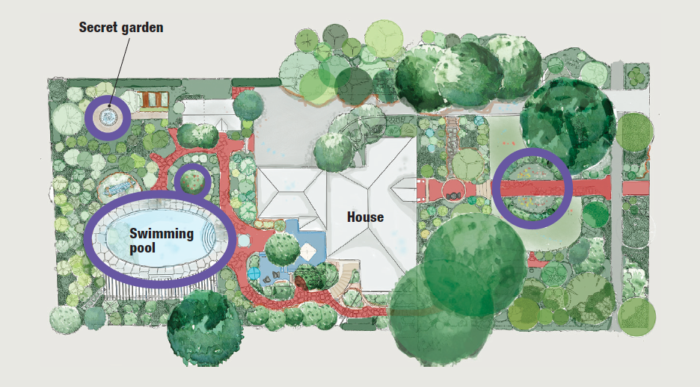
Three favorite plants with curves
Arching stems, rounded leaves, and mounded forms lend a sense of orderly abundance to this garden. Here are three key plants that will lend curve appeal to any garden.
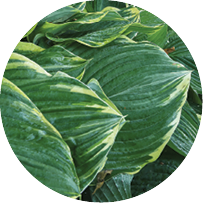
‘Sagae’ hosta
(Hosta ‘Sagae’, USDA Hardiness Zones 3–8)
Subtly variegated ‘Sagae’ flanks the stone steps leading up to the front door. This vigorous hosta grows up to 3 feet tall and wide, pairing well with equally substantial ‘Elegans’ hosta (Hosta seiboldii ‘Elegans’, Zones 4-9).

Sensitive fern
(Onoclea sensibilis, Zones 4–8)
Ferns’ arching stems and beautifully textured fronds are prominent throughout the Feldman garden. Sensitive fern, a North American native, thrives in shady, moist soil.

Japanese forest grass
(Hakonechloa macra ‘Aureola’, Zones 5–9)
Graceful, cascading blades have a fine texture that is the perfect foil for bolder foliage. The golden leaves of ‘Aureola’ lend brightness to partial shade and look especially appealing next to plants with blue-green leaves.
Carol Collins is the assistant editor.
Fine Gardening Recommended Products

Planting in a Post-Wild World: Designing Plant Communities for Resilient Landscapes
Fine Gardening receives a commission for items purchased through links on this site, including Amazon Associates and other affiliate advertising programs.
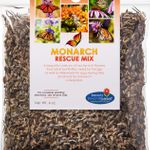
Monarch Butterfly Rescue Wildflower Seeds 4 oz.
Fine Gardening receives a commission for items purchased through links on this site, including Amazon Associates and other affiliate advertising programs.





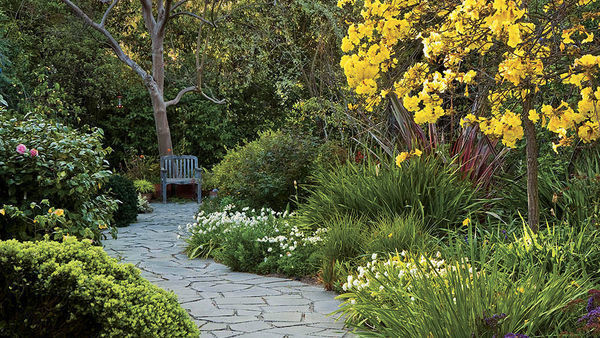













Comments
Log in or create an account to post a comment.
Sign up Log in